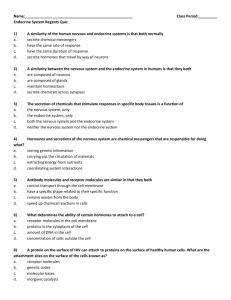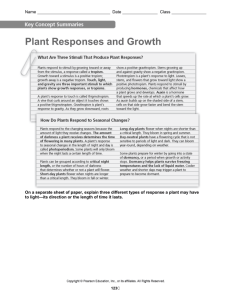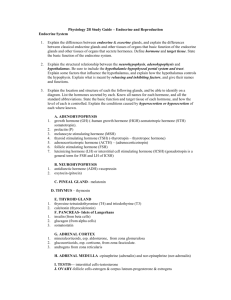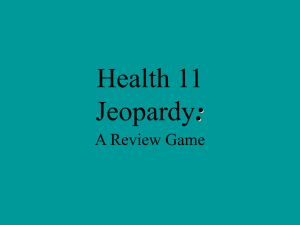Cellular communication
advertisement
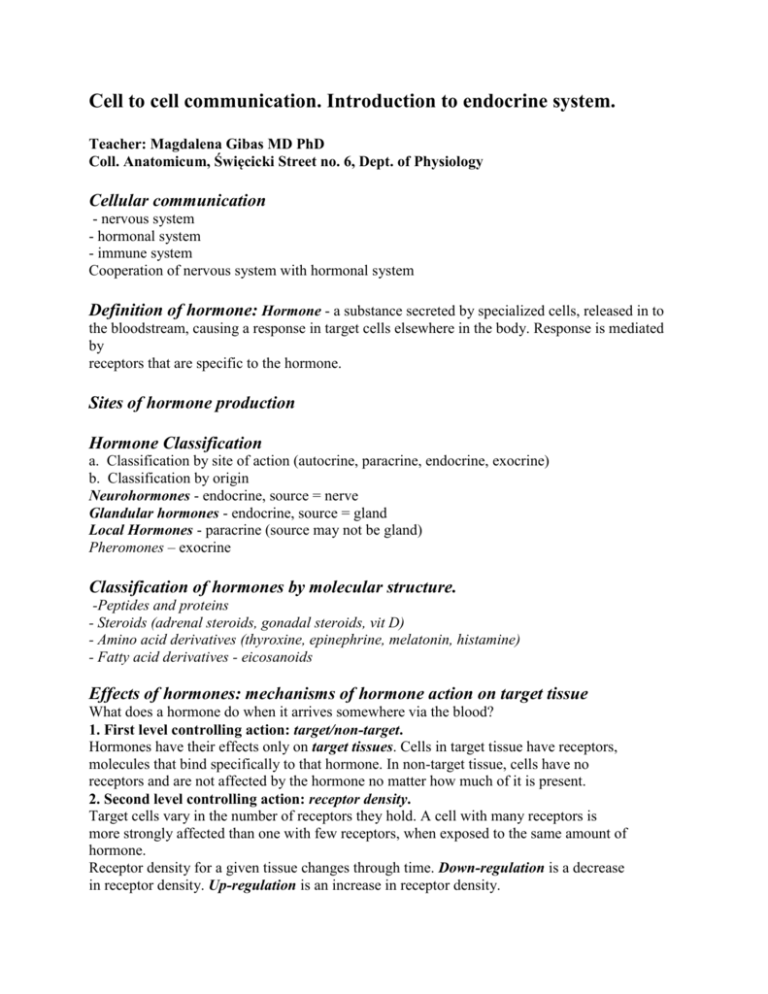
Cell to cell communication. Introduction to endocrine system. Teacher: Magdalena Gibas MD PhD Coll. Anatomicum, Święcicki Street no. 6, Dept. of Physiology Cellular communication - nervous system - hormonal system - immune system Cooperation of nervous system with hormonal system Definition of hormone: Hormone - a substance secreted by specialized cells, released in to the bloodstream, causing a response in target cells elsewhere in the body. Response is mediated by receptors that are specific to the hormone. Sites of hormone production Hormone Classification a. Classification by site of action (autocrine, paracrine, endocrine, exocrine) b. Classification by origin Neurohormones - endocrine, source = nerve Glandular hormones - endocrine, source = gland Local Hormones - paracrine (source may not be gland) Pheromones – exocrine Classification of hormones by molecular structure. -Peptides and proteins - Steroids (adrenal steroids, gonadal steroids, vit D) - Amino acid derivatives (thyroxine, epinephrine, melatonin, histamine) - Fatty acid derivatives - eicosanoids Effects of hormones: mechanisms of hormone action on target tissue What does a hormone do when it arrives somewhere via the blood? 1. First level controlling action: target/non-target. Hormones have their effects only on target tissues. Cells in target tissue have receptors, molecules that bind specifically to that hormone. In non-target tissue, cells have no receptors and are not affected by the hormone no matter how much of it is present. 2. Second level controlling action: receptor density. Target cells vary in the number of receptors they hold. A cell with many receptors is more strongly affected than one with few receptors, when exposed to the same amount of hormone. Receptor density for a given tissue changes through time. Down-regulation is a decrease in receptor density. Up-regulation is an increase in receptor density. Down and up-regulation commonly respond to the amount of hormone in circulation over the long-term, as a damping mechanism. If blood concentration of cortisol (a stress hormone from the cortex of the adrenal gland) is high for a long time, receptor densities will decrease to modulate the response. 3. Third level of control: cellular mechanisms of action. Once they arrive at a target cell, peptide and steroid hormones have different mechanisms of action. The difference is based on fat-solubility, which determines whether or not the hormone can penetrate the target cell's plasma membrane (which is a lipid bilayer). Peptides are not fat soluble, so they bind to receptors on the target cell's surface, and act via a 'second messenger' in the cell. Second messenger is cyclic adenosine monophosphate. CAMP activates an enzyme (a protein kinase), which activates other proteins that produce the final 'effect' once secreted from the cell. Peptides don't directly alter gene expression, so the effects are generally short-term. Steroids are fat soluble, so they bind to receptors in the cytoplasm, either in the cytosol or directly in the nucleus. When the steroid binds to the receptor, it disinhibits a DNA binding site on the receptor. The steroid-receptor complex then moves into the nucleus and activates or suppresses specific genes. By altering gene expression, steroids produce long-lasting effects. 4. Second messenger mechanism of activation, types of second messengers, amplification. 5. Modulation of an endocrine response. 1. Feedforward circuit or open loop. 2. Feedback or closed loops Short loop - hormone A affects secretion of hormone B, and hormone B affects secretion of A . No intervening steps. Long loop - hormone A affects secretion of B, hormone B affects secretion of C, and hormone C affects secretion of A. Intermediate steps. Feedback is usually negative, so that endocrine response is self-limiting; secretion modulates itself and does not 'run away'. Feedback is sometimes positive, when a quick, large response is necessary Hormone Receptors: - membrane receptor classes – four types (with G proteins, with enzymatic properties, interacting with tyrosine kinase, opening ion channels) - intracellular receptors – two classes Hypo- and hyperfunction of endocrine glands – mechanisms and samples




